Literature Review: Religion, Spirituality, Age and Health Research
VerifiedAdded on 2023/06/09
|6
|1835
|410
Report
AI Summary
This report examines the complex interplay between religion, spirituality, age, and health, drawing on four key research articles. The first article by Aldwin et al. (2014) explores the differing pathways through which religiousness and spirituality impact physical and mental health, highlighting the roles of self-regulation and emotional regulation. Lucchetti et al. (2011) investigate the effects of religiousness on mental health, pain, and quality of life in older adults undergoing outpatient rehabilitation, revealing positive correlations. Rasic et al. (2011) analyze the longitudinal relationships between religious worship attendance, spirituality, and mental health outcomes, including depression, anxiety, and suicidal ideation. Finally, Stanley et al. (2011) focus on older adults' preferences for incorporating religion and spirituality into treatment for anxiety and depression. The report synthesizes the strengths and weaknesses of each study, considering implications for pastoral care and clinical interventions. The studies collectively suggest that religious and spiritual practices can have significant benefits for health and well-being, particularly in older populations, and should be considered in healthcare and therapeutic settings.
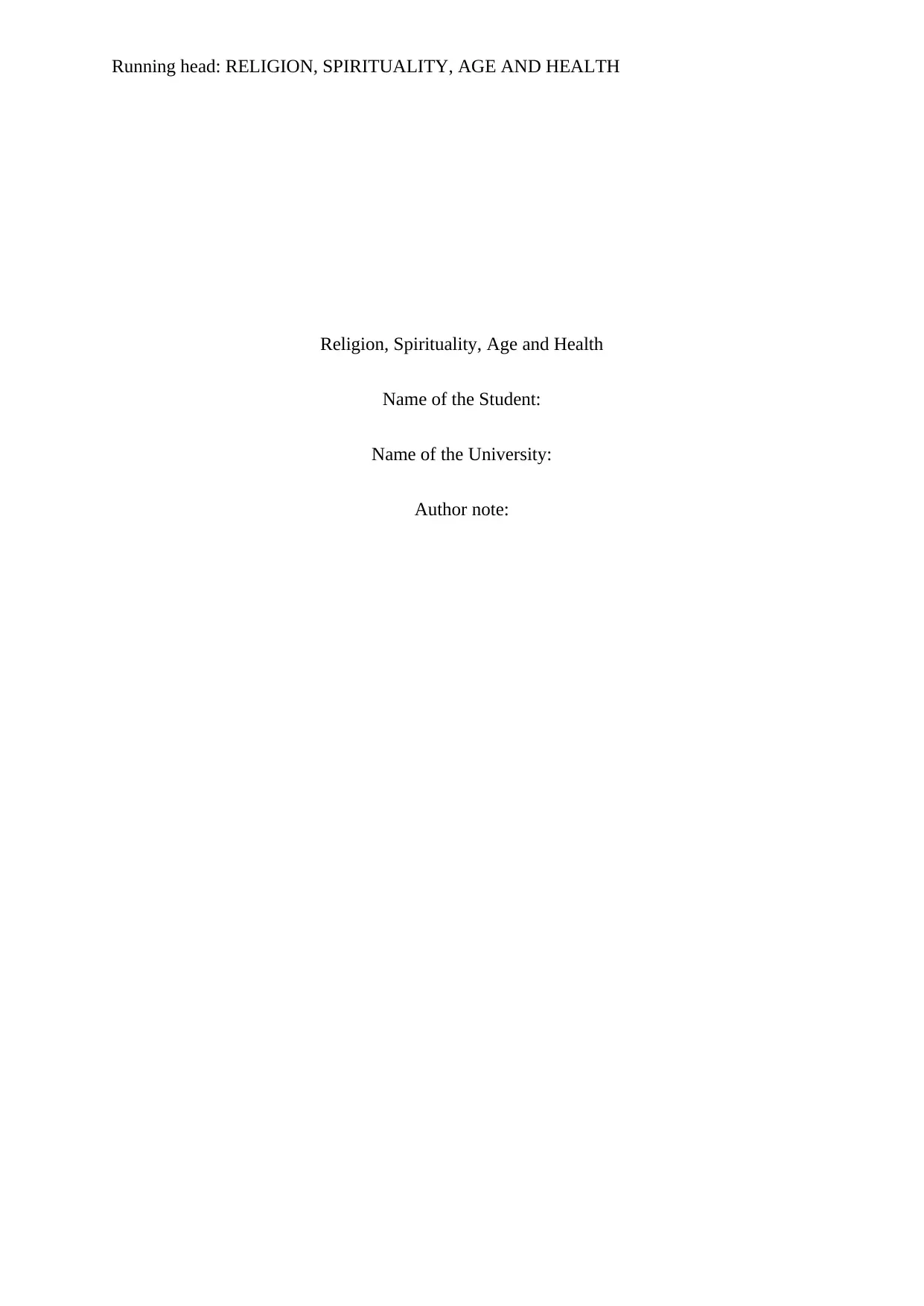
Running head: RELIGION, SPIRITUALITY, AGE AND HEALTH
Religion, Spirituality, Age and Health
Name of the Student:
Name of the University:
Author note:
Religion, Spirituality, Age and Health
Name of the Student:
Name of the University:
Author note:
Paraphrase This Document
Need a fresh take? Get an instant paraphrase of this document with our AI Paraphraser
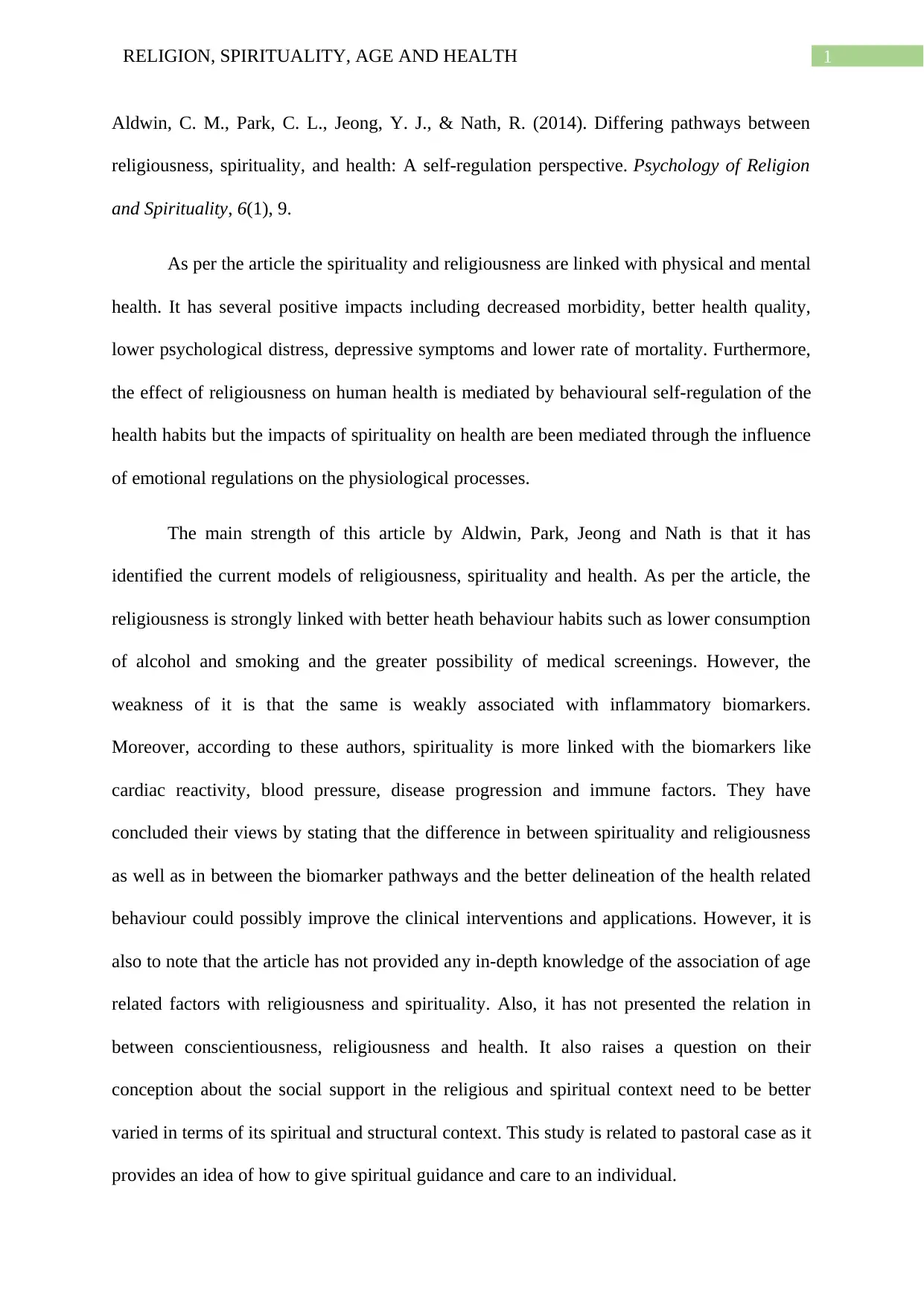
1RELIGION, SPIRITUALITY, AGE AND HEALTH
Aldwin, C. M., Park, C. L., Jeong, Y. J., & Nath, R. (2014). Differing pathways between
religiousness, spirituality, and health: A self-regulation perspective. Psychology of Religion
and Spirituality, 6(1), 9.
As per the article the spirituality and religiousness are linked with physical and mental
health. It has several positive impacts including decreased morbidity, better health quality,
lower psychological distress, depressive symptoms and lower rate of mortality. Furthermore,
the effect of religiousness on human health is mediated by behavioural self-regulation of the
health habits but the impacts of spirituality on health are been mediated through the influence
of emotional regulations on the physiological processes.
The main strength of this article by Aldwin, Park, Jeong and Nath is that it has
identified the current models of religiousness, spirituality and health. As per the article, the
religiousness is strongly linked with better heath behaviour habits such as lower consumption
of alcohol and smoking and the greater possibility of medical screenings. However, the
weakness of it is that the same is weakly associated with inflammatory biomarkers.
Moreover, according to these authors, spirituality is more linked with the biomarkers like
cardiac reactivity, blood pressure, disease progression and immune factors. They have
concluded their views by stating that the difference in between spirituality and religiousness
as well as in between the biomarker pathways and the better delineation of the health related
behaviour could possibly improve the clinical interventions and applications. However, it is
also to note that the article has not provided any in-depth knowledge of the association of age
related factors with religiousness and spirituality. Also, it has not presented the relation in
between conscientiousness, religiousness and health. It also raises a question on their
conception about the social support in the religious and spiritual context need to be better
varied in terms of its spiritual and structural context. This study is related to pastoral case as it
provides an idea of how to give spiritual guidance and care to an individual.
Aldwin, C. M., Park, C. L., Jeong, Y. J., & Nath, R. (2014). Differing pathways between
religiousness, spirituality, and health: A self-regulation perspective. Psychology of Religion
and Spirituality, 6(1), 9.
As per the article the spirituality and religiousness are linked with physical and mental
health. It has several positive impacts including decreased morbidity, better health quality,
lower psychological distress, depressive symptoms and lower rate of mortality. Furthermore,
the effect of religiousness on human health is mediated by behavioural self-regulation of the
health habits but the impacts of spirituality on health are been mediated through the influence
of emotional regulations on the physiological processes.
The main strength of this article by Aldwin, Park, Jeong and Nath is that it has
identified the current models of religiousness, spirituality and health. As per the article, the
religiousness is strongly linked with better heath behaviour habits such as lower consumption
of alcohol and smoking and the greater possibility of medical screenings. However, the
weakness of it is that the same is weakly associated with inflammatory biomarkers.
Moreover, according to these authors, spirituality is more linked with the biomarkers like
cardiac reactivity, blood pressure, disease progression and immune factors. They have
concluded their views by stating that the difference in between spirituality and religiousness
as well as in between the biomarker pathways and the better delineation of the health related
behaviour could possibly improve the clinical interventions and applications. However, it is
also to note that the article has not provided any in-depth knowledge of the association of age
related factors with religiousness and spirituality. Also, it has not presented the relation in
between conscientiousness, religiousness and health. It also raises a question on their
conception about the social support in the religious and spiritual context need to be better
varied in terms of its spiritual and structural context. This study is related to pastoral case as it
provides an idea of how to give spiritual guidance and care to an individual.
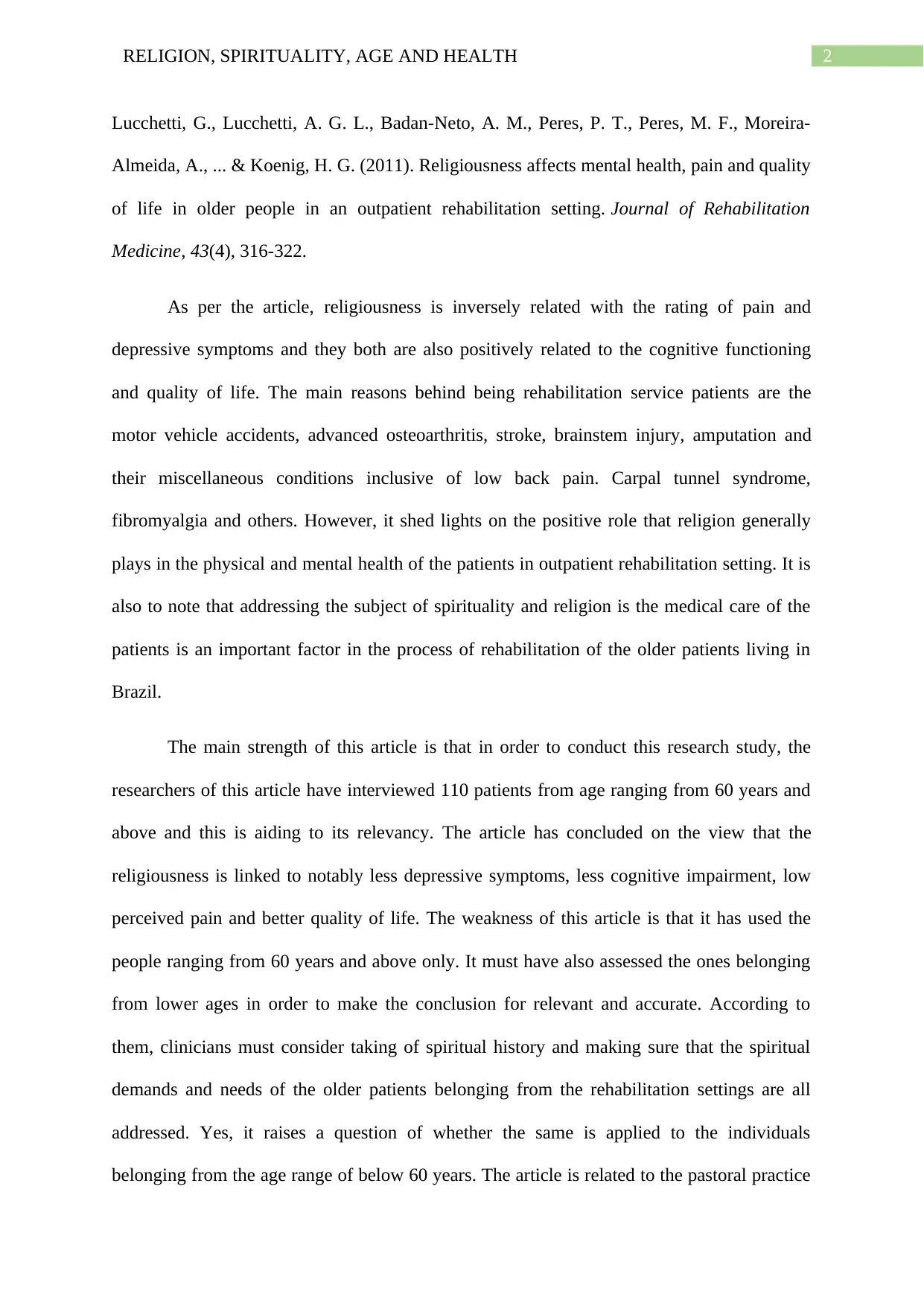
2RELIGION, SPIRITUALITY, AGE AND HEALTH
Lucchetti, G., Lucchetti, A. G. L., Badan-Neto, A. M., Peres, P. T., Peres, M. F., Moreira-
Almeida, A., ... & Koenig, H. G. (2011). Religiousness affects mental health, pain and quality
of life in older people in an outpatient rehabilitation setting. Journal of Rehabilitation
Medicine, 43(4), 316-322.
As per the article, religiousness is inversely related with the rating of pain and
depressive symptoms and they both are also positively related to the cognitive functioning
and quality of life. The main reasons behind being rehabilitation service patients are the
motor vehicle accidents, advanced osteoarthritis, stroke, brainstem injury, amputation and
their miscellaneous conditions inclusive of low back pain. Carpal tunnel syndrome,
fibromyalgia and others. However, it shed lights on the positive role that religion generally
plays in the physical and mental health of the patients in outpatient rehabilitation setting. It is
also to note that addressing the subject of spirituality and religion is the medical care of the
patients is an important factor in the process of rehabilitation of the older patients living in
Brazil.
The main strength of this article is that in order to conduct this research study, the
researchers of this article have interviewed 110 patients from age ranging from 60 years and
above and this is aiding to its relevancy. The article has concluded on the view that the
religiousness is linked to notably less depressive symptoms, less cognitive impairment, low
perceived pain and better quality of life. The weakness of this article is that it has used the
people ranging from 60 years and above only. It must have also assessed the ones belonging
from lower ages in order to make the conclusion for relevant and accurate. According to
them, clinicians must consider taking of spiritual history and making sure that the spiritual
demands and needs of the older patients belonging from the rehabilitation settings are all
addressed. Yes, it raises a question of whether the same is applied to the individuals
belonging from the age range of below 60 years. The article is related to the pastoral practice
Lucchetti, G., Lucchetti, A. G. L., Badan-Neto, A. M., Peres, P. T., Peres, M. F., Moreira-
Almeida, A., ... & Koenig, H. G. (2011). Religiousness affects mental health, pain and quality
of life in older people in an outpatient rehabilitation setting. Journal of Rehabilitation
Medicine, 43(4), 316-322.
As per the article, religiousness is inversely related with the rating of pain and
depressive symptoms and they both are also positively related to the cognitive functioning
and quality of life. The main reasons behind being rehabilitation service patients are the
motor vehicle accidents, advanced osteoarthritis, stroke, brainstem injury, amputation and
their miscellaneous conditions inclusive of low back pain. Carpal tunnel syndrome,
fibromyalgia and others. However, it shed lights on the positive role that religion generally
plays in the physical and mental health of the patients in outpatient rehabilitation setting. It is
also to note that addressing the subject of spirituality and religion is the medical care of the
patients is an important factor in the process of rehabilitation of the older patients living in
Brazil.
The main strength of this article is that in order to conduct this research study, the
researchers of this article have interviewed 110 patients from age ranging from 60 years and
above and this is aiding to its relevancy. The article has concluded on the view that the
religiousness is linked to notably less depressive symptoms, less cognitive impairment, low
perceived pain and better quality of life. The weakness of this article is that it has used the
people ranging from 60 years and above only. It must have also assessed the ones belonging
from lower ages in order to make the conclusion for relevant and accurate. According to
them, clinicians must consider taking of spiritual history and making sure that the spiritual
demands and needs of the older patients belonging from the rehabilitation settings are all
addressed. Yes, it raises a question of whether the same is applied to the individuals
belonging from the age range of below 60 years. The article is related to the pastoral practice
⊘ This is a preview!⊘
Do you want full access?
Subscribe today to unlock all pages.

Trusted by 1+ million students worldwide
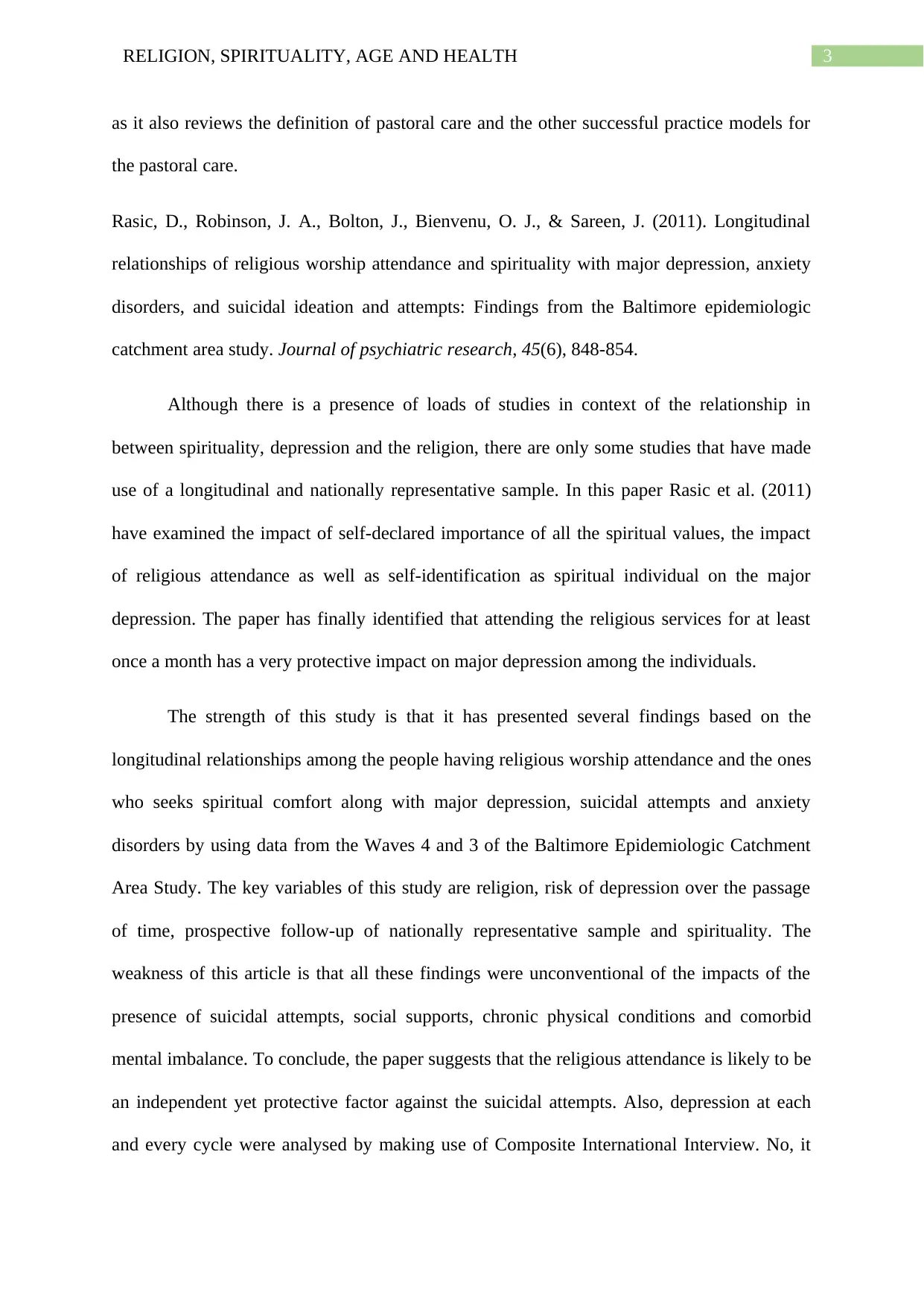
3RELIGION, SPIRITUALITY, AGE AND HEALTH
as it also reviews the definition of pastoral care and the other successful practice models for
the pastoral care.
Rasic, D., Robinson, J. A., Bolton, J., Bienvenu, O. J., & Sareen, J. (2011). Longitudinal
relationships of religious worship attendance and spirituality with major depression, anxiety
disorders, and suicidal ideation and attempts: Findings from the Baltimore epidemiologic
catchment area study. Journal of psychiatric research, 45(6), 848-854.
Although there is a presence of loads of studies in context of the relationship in
between spirituality, depression and the religion, there are only some studies that have made
use of a longitudinal and nationally representative sample. In this paper Rasic et al. (2011)
have examined the impact of self-declared importance of all the spiritual values, the impact
of religious attendance as well as self-identification as spiritual individual on the major
depression. The paper has finally identified that attending the religious services for at least
once a month has a very protective impact on major depression among the individuals.
The strength of this study is that it has presented several findings based on the
longitudinal relationships among the people having religious worship attendance and the ones
who seeks spiritual comfort along with major depression, suicidal attempts and anxiety
disorders by using data from the Waves 4 and 3 of the Baltimore Epidemiologic Catchment
Area Study. The key variables of this study are religion, risk of depression over the passage
of time, prospective follow-up of nationally representative sample and spirituality. The
weakness of this article is that all these findings were unconventional of the impacts of the
presence of suicidal attempts, social supports, chronic physical conditions and comorbid
mental imbalance. To conclude, the paper suggests that the religious attendance is likely to be
an independent yet protective factor against the suicidal attempts. Also, depression at each
and every cycle were analysed by making use of Composite International Interview. No, it
as it also reviews the definition of pastoral care and the other successful practice models for
the pastoral care.
Rasic, D., Robinson, J. A., Bolton, J., Bienvenu, O. J., & Sareen, J. (2011). Longitudinal
relationships of religious worship attendance and spirituality with major depression, anxiety
disorders, and suicidal ideation and attempts: Findings from the Baltimore epidemiologic
catchment area study. Journal of psychiatric research, 45(6), 848-854.
Although there is a presence of loads of studies in context of the relationship in
between spirituality, depression and the religion, there are only some studies that have made
use of a longitudinal and nationally representative sample. In this paper Rasic et al. (2011)
have examined the impact of self-declared importance of all the spiritual values, the impact
of religious attendance as well as self-identification as spiritual individual on the major
depression. The paper has finally identified that attending the religious services for at least
once a month has a very protective impact on major depression among the individuals.
The strength of this study is that it has presented several findings based on the
longitudinal relationships among the people having religious worship attendance and the ones
who seeks spiritual comfort along with major depression, suicidal attempts and anxiety
disorders by using data from the Waves 4 and 3 of the Baltimore Epidemiologic Catchment
Area Study. The key variables of this study are religion, risk of depression over the passage
of time, prospective follow-up of nationally representative sample and spirituality. The
weakness of this article is that all these findings were unconventional of the impacts of the
presence of suicidal attempts, social supports, chronic physical conditions and comorbid
mental imbalance. To conclude, the paper suggests that the religious attendance is likely to be
an independent yet protective factor against the suicidal attempts. Also, depression at each
and every cycle were analysed by making use of Composite International Interview. No, it
Paraphrase This Document
Need a fresh take? Get an instant paraphrase of this document with our AI Paraphraser
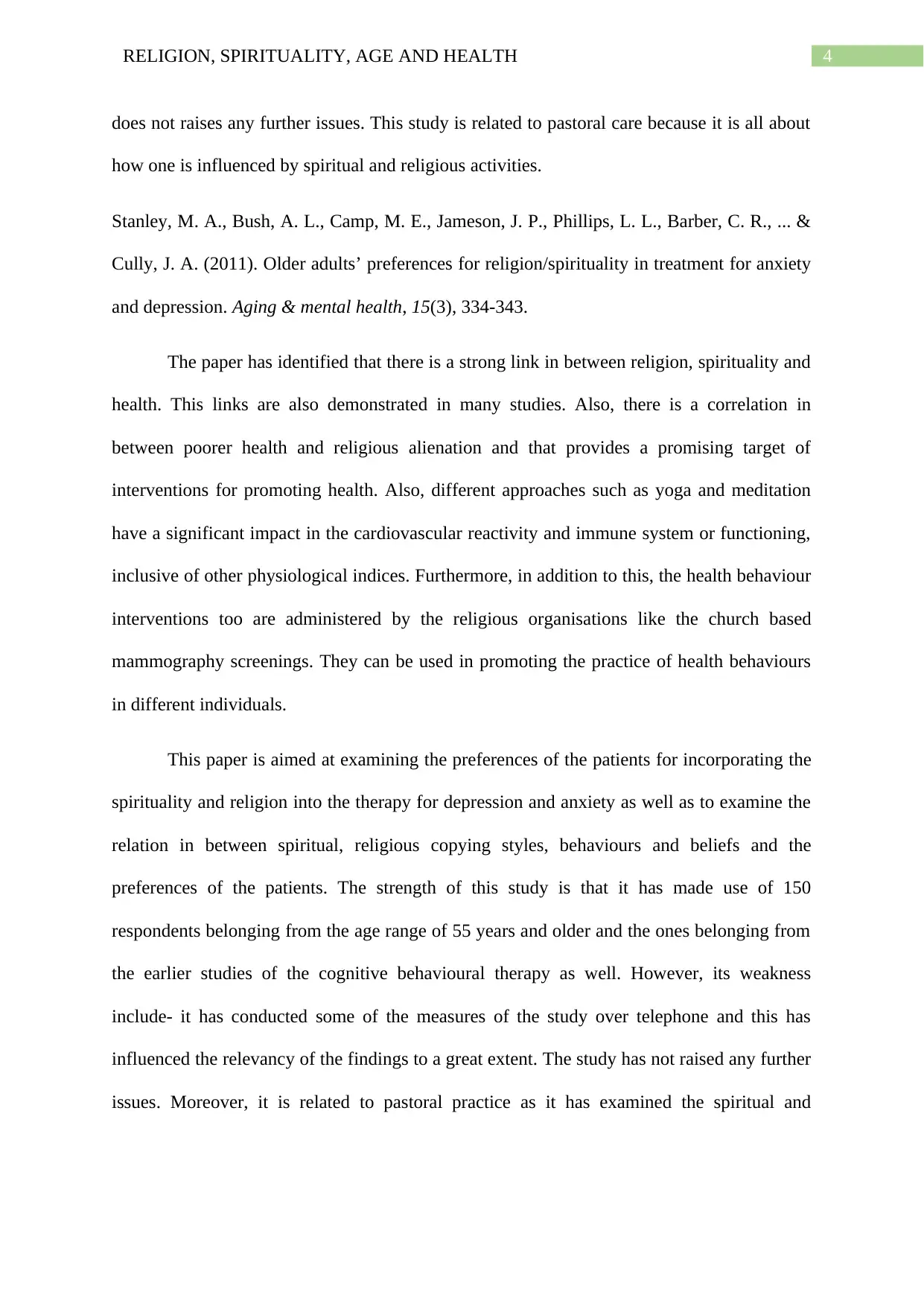
4RELIGION, SPIRITUALITY, AGE AND HEALTH
does not raises any further issues. This study is related to pastoral care because it is all about
how one is influenced by spiritual and religious activities.
Stanley, M. A., Bush, A. L., Camp, M. E., Jameson, J. P., Phillips, L. L., Barber, C. R., ... &
Cully, J. A. (2011). Older adults’ preferences for religion/spirituality in treatment for anxiety
and depression. Aging & mental health, 15(3), 334-343.
The paper has identified that there is a strong link in between religion, spirituality and
health. This links are also demonstrated in many studies. Also, there is a correlation in
between poorer health and religious alienation and that provides a promising target of
interventions for promoting health. Also, different approaches such as yoga and meditation
have a significant impact in the cardiovascular reactivity and immune system or functioning,
inclusive of other physiological indices. Furthermore, in addition to this, the health behaviour
interventions too are administered by the religious organisations like the church based
mammography screenings. They can be used in promoting the practice of health behaviours
in different individuals.
This paper is aimed at examining the preferences of the patients for incorporating the
spirituality and religion into the therapy for depression and anxiety as well as to examine the
relation in between spiritual, religious copying styles, behaviours and beliefs and the
preferences of the patients. The strength of this study is that it has made use of 150
respondents belonging from the age range of 55 years and older and the ones belonging from
the earlier studies of the cognitive behavioural therapy as well. However, its weakness
include- it has conducted some of the measures of the study over telephone and this has
influenced the relevancy of the findings to a great extent. The study has not raised any further
issues. Moreover, it is related to pastoral practice as it has examined the spiritual and
does not raises any further issues. This study is related to pastoral care because it is all about
how one is influenced by spiritual and religious activities.
Stanley, M. A., Bush, A. L., Camp, M. E., Jameson, J. P., Phillips, L. L., Barber, C. R., ... &
Cully, J. A. (2011). Older adults’ preferences for religion/spirituality in treatment for anxiety
and depression. Aging & mental health, 15(3), 334-343.
The paper has identified that there is a strong link in between religion, spirituality and
health. This links are also demonstrated in many studies. Also, there is a correlation in
between poorer health and religious alienation and that provides a promising target of
interventions for promoting health. Also, different approaches such as yoga and meditation
have a significant impact in the cardiovascular reactivity and immune system or functioning,
inclusive of other physiological indices. Furthermore, in addition to this, the health behaviour
interventions too are administered by the religious organisations like the church based
mammography screenings. They can be used in promoting the practice of health behaviours
in different individuals.
This paper is aimed at examining the preferences of the patients for incorporating the
spirituality and religion into the therapy for depression and anxiety as well as to examine the
relation in between spiritual, religious copying styles, behaviours and beliefs and the
preferences of the patients. The strength of this study is that it has made use of 150
respondents belonging from the age range of 55 years and older and the ones belonging from
the earlier studies of the cognitive behavioural therapy as well. However, its weakness
include- it has conducted some of the measures of the study over telephone and this has
influenced the relevancy of the findings to a great extent. The study has not raised any further
issues. Moreover, it is related to pastoral practice as it has examined the spiritual and
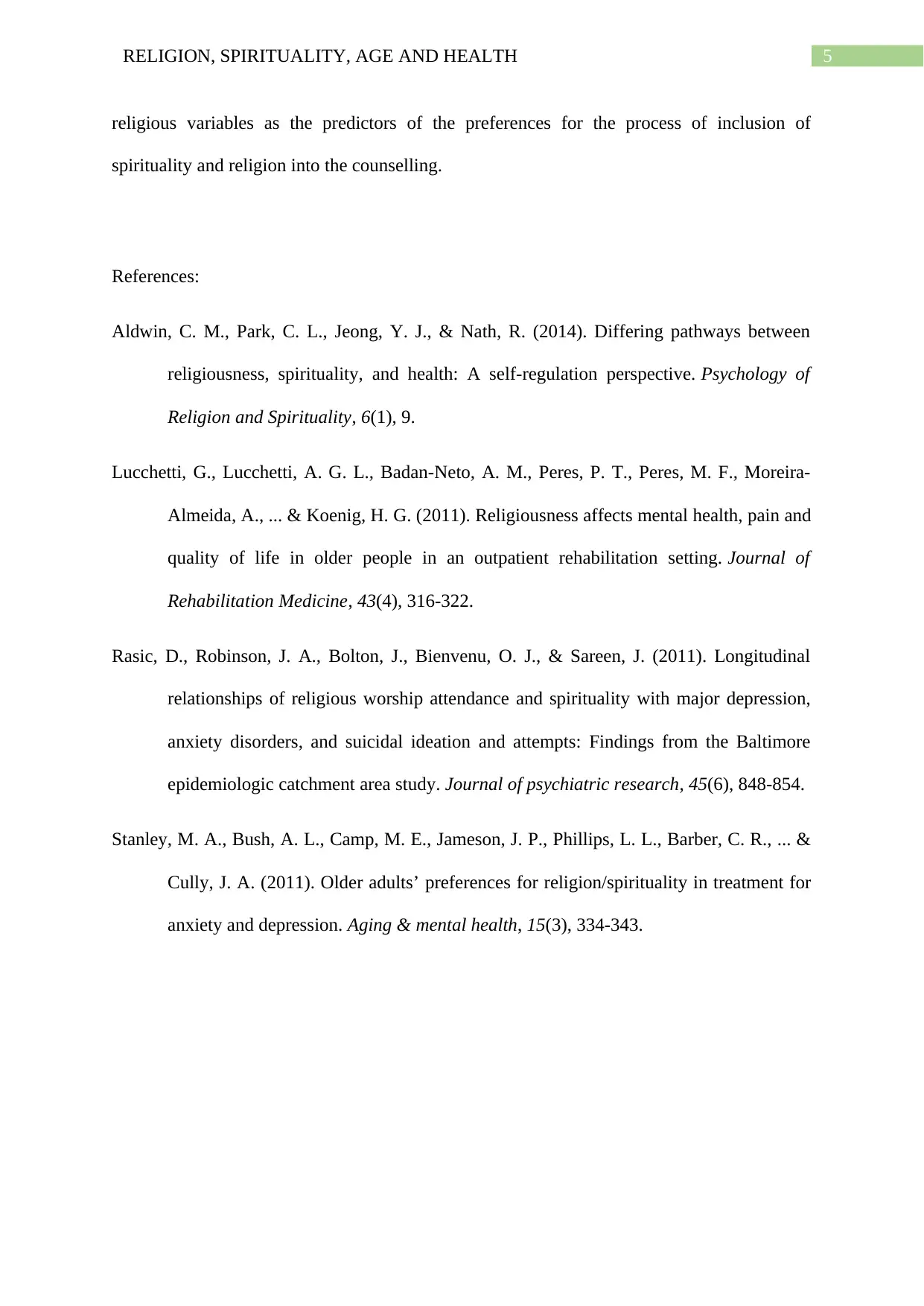
5RELIGION, SPIRITUALITY, AGE AND HEALTH
religious variables as the predictors of the preferences for the process of inclusion of
spirituality and religion into the counselling.
References:
Aldwin, C. M., Park, C. L., Jeong, Y. J., & Nath, R. (2014). Differing pathways between
religiousness, spirituality, and health: A self-regulation perspective. Psychology of
Religion and Spirituality, 6(1), 9.
Lucchetti, G., Lucchetti, A. G. L., Badan-Neto, A. M., Peres, P. T., Peres, M. F., Moreira-
Almeida, A., ... & Koenig, H. G. (2011). Religiousness affects mental health, pain and
quality of life in older people in an outpatient rehabilitation setting. Journal of
Rehabilitation Medicine, 43(4), 316-322.
Rasic, D., Robinson, J. A., Bolton, J., Bienvenu, O. J., & Sareen, J. (2011). Longitudinal
relationships of religious worship attendance and spirituality with major depression,
anxiety disorders, and suicidal ideation and attempts: Findings from the Baltimore
epidemiologic catchment area study. Journal of psychiatric research, 45(6), 848-854.
Stanley, M. A., Bush, A. L., Camp, M. E., Jameson, J. P., Phillips, L. L., Barber, C. R., ... &
Cully, J. A. (2011). Older adults’ preferences for religion/spirituality in treatment for
anxiety and depression. Aging & mental health, 15(3), 334-343.
religious variables as the predictors of the preferences for the process of inclusion of
spirituality and religion into the counselling.
References:
Aldwin, C. M., Park, C. L., Jeong, Y. J., & Nath, R. (2014). Differing pathways between
religiousness, spirituality, and health: A self-regulation perspective. Psychology of
Religion and Spirituality, 6(1), 9.
Lucchetti, G., Lucchetti, A. G. L., Badan-Neto, A. M., Peres, P. T., Peres, M. F., Moreira-
Almeida, A., ... & Koenig, H. G. (2011). Religiousness affects mental health, pain and
quality of life in older people in an outpatient rehabilitation setting. Journal of
Rehabilitation Medicine, 43(4), 316-322.
Rasic, D., Robinson, J. A., Bolton, J., Bienvenu, O. J., & Sareen, J. (2011). Longitudinal
relationships of religious worship attendance and spirituality with major depression,
anxiety disorders, and suicidal ideation and attempts: Findings from the Baltimore
epidemiologic catchment area study. Journal of psychiatric research, 45(6), 848-854.
Stanley, M. A., Bush, A. L., Camp, M. E., Jameson, J. P., Phillips, L. L., Barber, C. R., ... &
Cully, J. A. (2011). Older adults’ preferences for religion/spirituality in treatment for
anxiety and depression. Aging & mental health, 15(3), 334-343.
⊘ This is a preview!⊘
Do you want full access?
Subscribe today to unlock all pages.

Trusted by 1+ million students worldwide
1 out of 6
Your All-in-One AI-Powered Toolkit for Academic Success.
+13062052269
info@desklib.com
Available 24*7 on WhatsApp / Email
![[object Object]](/_next/static/media/star-bottom.7253800d.svg)
Unlock your academic potential
Copyright © 2020–2025 A2Z Services. All Rights Reserved. Developed and managed by ZUCOL.